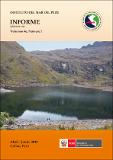Por favor, use este identificador para citar o enlazar este ítem:
https://hdl.handle.net/20.500.12958/3343| Título : | Prospección biológico poblacional del cangrejo del manglar (Ucides occidentalis) en la región Tumbes, Perú. Diciembre 2016 |
| Otros títulos : | Biological and population assessment of mangrove crab (Ucides occidentalis) in the Tumbes Region, Peru. December 2016 |
| Autor : | Alemán Mejía, Solange Alexander Montero, Percy Ordinola Zapata, Elmer Guevara Torres, Mervin |
| Palabras clave : | Ucides occidentalis;Biología;Características ambientales |
| Fecha de publicación : | 2019 |
| Editorial : | Instituto del Mar del Perú |
| Citación : | Inf Inst Mar Perú 46(2), 2019, p.269-278 |
| Citación : | Informe IMARPE;46(2), 2019 |
| Resumen : | Entre el 12
y 16 de diciembre 2016, se evaluó la población del cangrejo del manglar Ucides occidentales en 75 estaciones
localizadas en canales de marea e islas de la región Tumbes. La densidad promedio fue 2,8 ind.m-2. Las
densidades no presentaron asociación estadísticamente significativa con los parámetros físico-químicos
del agua pero presentaron asociación inversa y moderadamente baja con el pH del sedimento en la zona
centro. El mayor índice de abundancia se localizó en la zona sur (3,6 ind.m-2) y el más bajo en la zona centro
(2,3 ind.m-2). La proporción sexual fue favorable a los machos (1,7: 1) que presentaron tallas mayores (76,8
mm de ancho de cefalotórax AC), respecto a las hembras (69,3 mm AC), se registró alta proporción de
madurantes en ambos sexos. El 83,6% de hembras y 95,3% de machos estuvo en talla comercial (≥65 mm
AC). 75,1% de las madrigueras estuvieron activas y 24,5% inactivas (tapadas). ABSTRACT: From 12 to 16 December 2016, the population of the mangrove crab Ucides occidentalis was assessed in 75 stations located in tidal channels and islands of the Tumbes region. The mean density was 2.8 ind.m-2. The densities did not show a statistically significant association with the physical-chemical parameters of the water but presented an inverse and moderately low association with the pH of the sediment in the central zone. The highest index of abundance was in the southern zone (3.6 ind.m-2) and the lowest in the central zone (2.3 ind.m-2). The sex ratio was favorable to males (1.7: 1) that were of larger sizes (76.8 mm of cephalothorax width CW), compared to females (69.3 mm CW), there was a high proportion of maturing in both sexes. 83.6% of females and 95.3% of males were at commercial size (≥65 mm CW). The burrows were 75.1% active and 24.5% inactive (covered). |
| URI : | https://hdl.handle.net/20.500.12958/3343 |
| Aparece en las colecciones: | Informe vol. 46(2) 2019 |
Ficheros en este ítem:
| Fichero | Descripción | Tamaño | Formato | |
|---|---|---|---|---|
| Informe 46-4.pdf | 20,58 MB | Adobe PDF |  Visualizar/Abrir |
Este ítem está sujeto a una licencia Creative Commons Licencia Creative Commons

